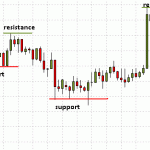How to Use Support and Resistance in Trading

If you are to succeed in this journey we call Forex trading, you cannot run away from the concept of support and resistance. You need to know when bullish runs will take a breather, and you also need to know when traders will tire of selling. Some of you have at one time or the other, placed trades with very ambitious targets of maybe 300 pips, only for you to see the market move in your favour by maybe 130 pips, and then turn against you, eroding all profit and even going into a loss. What happened? More often than not, this is because your targets exceeded the support/resistance points of those trades, and once the price action got to the appropriate key levels, it failed to break these levels and promptly retreated. This underscores the importance of support and resistance in Forex trading. We will highlight a couple of ways to use support and resistance in trading in this article.
What is support/resistance? A support is a price level that forms a downside barrier for the market, making it hard for the market to get below that level. Resistance can be described as a price level that forms an upside barrier for the market, making it difficult for the market to break above it.
Where Does the Market Form Support and Resistance?
There are no hard and fast rules about where support and resistance live on a chart. However, there are certain areas where prices are likely to form supports and resistance. One way of determining these areas is by the use of pivot points. Intraday pivot points consist of three support levels (S1, S2, S3), three resistance levels (R1, R2, R3) and a central pivot. Other pivots exist (weekly and monthly pivots), but they are mostly for long term traders. The easiest way to trace these intraday pivots on your chart is by using an Autopivot Calculator. Once this tool is attached to the 1 hour chart, it automatically updates the pivot points daily.
Another way of detecting supports and resistance points on the chart is to look at areas where the candlesticks make common highs and common lows as seen on this chart below:
Using Support and Resistance in Trading
The best use of support and resistance is in setting trade entries and exits. If we look at the first chart, one thing is obvious. Even though there will be periods of occasional breakout, the scenario that plays out most of the time is that the price action moves from a support to resistance and then halts, while price moves from the resistance levels to the supports before halting.
Trade Entries
It's good practice to buy as close to a support as possible so that when you set your stop loss, the stop will be below the support and not above it. That way, retreating prices will probably bounce off the support without triggering the stop. In the same vein, you should sell as close to a resistance as possible, so that the stop loss will be located above the resistance and not below it. A momentary price advance will therefore probably hit a brick wall at the resistance without triggering the stop loss. There is the issue of stop hunting but we'll leave that discussion for another article
Trade Exits
The logical exit point for any long trade is the nearest resistance, while that for a short trade is the nearest support. These should be set as the first targets. What constitute the “nearest” supports and resistance levels?
This table shows us what the first targets should be, because any level above a key price level is a resistance and any level below the entry key level is a support.
The next resistance or support levels should only be used as 2nd targets, if there are very strong fundamental factors causing the advance or retreat, or if the price breaches a key level and closes above it (long trades) or below it (for short trades).
If you find yourself in the middle of nowhere price-wise, do not get tempted to just place a trade. Rather, identify the nearest key entry level based on what the supports and resistance are, and use a pending order instead.
If you follow these principles, never again will you have stops taken out prematurely or have your profits eroded by retreating prices. You will also never be lost about where to set your trade entries and exits.




